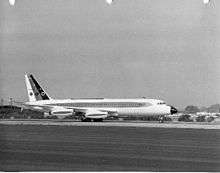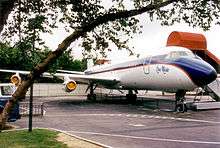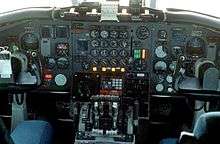Convair 880
| Convair 880 | |
|---|---|
 | |
| A Delta Air Lines 880 in flight shortly after delivery. Delta was a customer of the type, and had the second largest fleet, behind TWA. | |
| Role | Narrow-body jet airliner |
| Manufacturer | Convair |
| First flight | January 27, 1959 |
| Introduction | May 1960 with Delta Air Lines |
| Status | Retired |
| Primary users | Trans World Airlines Delta Air Lines Japan Airlines Swissair |
| Produced | 1959-1962 |
| Number built | 65 |
| Variants | Convair 990 |
The Convair 880 was a narrow-body jet airliner produced by the Convair division of General Dynamics. It was designed to compete with the Boeing 707 and Douglas DC-8 by being smaller and faster, a niche that failed to create demand. When it was first introduced some aviation circles claimed that at 615 mph (990 km/h) it was the fastest jet transport in the world.[1] Only 65 Convair 880s were produced over the lifetime of the production run from 1959 to 1962, and General Dynamics eventually withdrew from the airliner market after considering the 880 project a failure. The Convair 990 was a stretched and faster variant of the 880.
Design and development
Convair began development of a medium-range commercial jet in April 1956, to compete with announced products from Boeing and Douglas. Initially the design was called the Skylark but the name was later changed to the Golden Arrow, then Convair 600 and then finally the 880, both numbers referring to its top speed of 600 mph (970 km/h) or 880 ft/s (268 m/s). It was powered by General Electric CJ-805-3 turbojets, a civilian version of the J79 which powered the F-104 Starfighter, F-4 Phantom[2] and Convair B-58 Hustler.
The first example of the initial production version, the Model 22, made its maiden flight on January 27, 1959.[3] There was no prototype. After production started the FAA mandated additional instrumentation, which Convair added by placing a "raceway" hump on the top of the fuselage, rather than ripping apart the interiors over the wing area. The final assembly of the 880 and 990 took place at the Convair facilities in San Diego, California.[4]
The airliner never became widely used and the production line shut down after only three years. The 880's five-abreast seating made it unattractive to airlines, while Boeing was able to out-compete it with the Boeing 720, which could be sold much more cheaply as it was a minimal modification of the existing 707. In addition, the General Electric engines had a higher specific fuel consumption than the Boeing's Pratt & Whitney JT3Cs.
General Dynamics lost around $185 million over the lifetime of the project, although some sources estimate much higher losses. It is generally agreed that the losses incurred in the Convair 880/990 were the largest losses incurred by a corporation up to that time. The aircraft were involved in 17 accidents and five hijackings.
A modified version of the basic 880 was the "-M" version which incorporated four leading edge slats per wing, Krueger leading edge flaps between the fuselage and inboard engines, power-boosted rudder, added engine thrust, increased fuel capacity, stronger landing gear, greater adjustment to seating pitch and a simpler over-head compartment arrangement.[5]
A more major modification to the 880 became the Convair 990, produced in parallel with the 880-M between 1961 and 1963. Swissair named theirs Coronado, after an island off the San Diego coast and where the first 990 landed, despite Convair's flying boat with that name.[6]
Operational history

The design entered service with Delta Air Lines in May 1960, slightly modified as the 880-22m, having newer version 805-3B engines. 880s were flown by Cathay Pacific, Delta, Japan, Northeast, Swissair, TWA and VIASA.
As they left commercial service, many 880s were bought by American Jet Industries for various uses. One example was converted to freighter use in 1974, and flew until 1982 with various companies. Another was used to train FAA flight examiners until it was destroyed by a minor explosion in the cargo hold in 1995. Most of the remaining examples were scrapped by 2000.

The United States Navy acquired one 880-M in 1980 modifying it as an in-flight tanker. It had been purchased new from Convair by the FAA, and used for eighteen years.[7] Unofficially designated UC-880, it was assigned to the Naval Air Test Center, Patuxent River, and employed in Tomahawk Cruise Missile testing and aircraft refueling procedures.[8] Convair designed and manufactured the Tomahawk and Advanced Tomahawk Cruise Missile in San Diego where the 880 and 990 were produced. The sole UC-880 was damaged in a cargo hold explosive decompression test at NAS Patuxent River, Maryland in 1995.[9] The aircraft managed to remain theoretically controllable via backup systems unique to the 880 & 990.[10]
Operators




Civil operators
- Air Viking (leased)
- Airtrust Singapore (leased)
- Alaska Airlines
- American Jet Industries
- Cathay Pacific ♠
- Civil Air Transport ♠
- Delta Air Lines ♠
- Elvis Presley Enterprises
- Fair Air
- Federal Aviation Authority ♠
- Four Winds Inc
- Freelandia Travel Club
- Hughes Tool Company ♠
- Inair Panama (leased)
- Indy Air
- Japan Air Lines ♠
- Japan Domestic Airlines
- LANICA
- LatinCarga
- Monarch Aviation (leased)
- Northeast
- Orient Pacific Airways
- SERCA Costa Rica
- Trans World Airlines ♠
- Swissair ♠
- VIASA ♠
(♠ = original operators)
Military operators
- United States Navy - one Convair UC-880 testbed/air refuelling tanker.
Accidents and incidents
- On May 23, 1960, a Delta Air Lines Convair 880 N8804E crashed on takeoff at Atlanta Municipal Airport (now Atlanta Hartsfield-Jackson International) resulting in the loss of all four crew members. This flight was to be a training sortie for two Delta captains who were being type-rated on the 880. At rotation the aircraft pitched nose up, rolled left and then back more steeply to the right at which time it struck the ground, broke apart and was consumed by a post-crash fire.[11]
- On November 20, 1967, TWA Flight 128 crashed on approach to Cincinnati/Northern Kentucky International Airport. Seventy people were killed and twelve survived.[12]
- On March 19, 1969, a man tried to hijack a CV-880 from Dallas to Cuba but ended up in New Orleans. Charges were dismissed due to insanity.
- On June 15, 1972, a bomb exploded on board Cathay Pacific Flight 700Z killing 81 passengers and crew.[13]
- On December 20, 1972, North Central Airlines Flight 575, a McDonnell Douglas DC-9-31, collided during its takeoff roll with Delta Air Lines Flight 954, Convair 880 N8807E, as the Convair 880 taxied across the runway at O'Hare International Airport in Chicago, Illinois. Only two people on the Convair 880 were injured, and 10 people died and 15 were injured on board the DC-9.[14]
Survivors



- 1 – Cockpit on display at the Delta Flight Museum in Atlanta, Georgia.[15]
- 3 – Forward fuselage in storage at the Aviation Hall of Fame and Museum of New Jersey in Teterboro, New Jersey.[16][17]
- 23 – Forward fuselage in storage with Scroggins Aviation in Mojave, California. This airframe was cut up for scrap in April 2007, with the forward fuselage being saved for use in a museum.[18]
- 35 – In storage with Scroggins Aviation in Mojave, California.[19]
- 38 Lisa Marie – On display at Graceland in Memphis, Tennessee.[20][21] This airframe was used by Elvis Presley and is named after his daughter. It is the only properly preserved airframe. It was formerly in commercial service with Delta.[22] In January 2015 it was put up for sale and eventually bought back by Elvis Presley Enterprises, which shall continue exhibiting it as a part of the Presley Museum.[23]
- 58 – Converted into lodge in East London, South Africa.[24] This airframe was converted into a business jet in the 1970s (registration N88CH). It was purchased by the Ciskei government in 1987 intended for use by president Lennox Sebe, but remained at Bhisho Airport for several years due to a lack of funds to make it airworthy. In 1992 it was bought by Billy Nel (now Eastern Cape Provincial Finance MEC), who had it transported to his private residence north of East London, South Africa. The 1970s VIP interior with couches, beds and a bar remain intact and it is used for private functions. One of the engines was donated to the Stutterheim Engine Museum.[9][25][26][27]
Specifications (880 Model 22 & 22-M)
Data from Jane's All The World's Aircraft 1965-66 [28]
General characteristics
- Crew: 3
- Capacity: 110 passengers
- Payload: 24,000 lb (10,900 kg)
- Length: 129 ft 4 in (39.42 m)
- Wingspan: 120 ft 0 in (36.58 m)
- Height: 36 ft 3¾ in (11.00 m)
- Wing area: 2,000 sq ft (185.8 m²)
- Aspect ratio: 7.2
- Empty weight: 94,000 lb (42,730 kg)
- Max. takeoff weight: 193,000 lb (203,400 lb [880-M]) (87,730 kg)
- Powerplant: 4 × General Electric CJ-805-3B turbojet, 11,650 lbf (51.95 kN) each
Performance
- Cruise speed: 610 mph[29] (max. mach: .89 [approx. 615 MPH]) (535 knots, 990 km/h) (max cruise at 22,500 ft (6,860 m)
- Stall speed: 111 mph (97 knots, 179 km/h)
- Range: 3,385 mi (3,750 880-M) (2,943 nmi, 4,430 km)
- Service ceiling: 41,000 ft (12,500 m) (max cruise altitude)
See also
- Related development
- Aircraft of comparable role, configuration and era
- Related lists
References
- Notes
- ↑ "Here's Convair 880 - Fastest Jet Transport in the World."Popular Mechanics, March 1959, p. 87.
- ↑ Wegg 1990, p. 214.
- ↑ Wegg 1990. p. 215.
- ↑ Pourade. Richard F. "San Diego history." sandiegohistory.org. Retrieved: May 19, 2010.
- ↑ Proctor, Jon (1996). Convair 880& 990 (First ed.). Miami: World Transport Press. p. 13. ISBN 0-9626730-4-8.
- ↑ Proctor, Jon. Convair 880 & 990.
- ↑ Proctor, Jon (1996). Convair 880 & 990 (First ed.). Miami: World Transport Press. pp. 44–45. ISBN 0-9626730-4-8.
- ↑ Pugh, Vernon. "DVIC image DN-ST-92-10041."dodmedia.osd.mil. Retrieved: May 19, 2010.
- 1 2 Lockett, Brian. "Convair 880." Goleta Air & Space Museum. Retrieved: May 19, 2010.
- ↑ Proctor, Jon (1996). Convair 880 & 990 (First ed.). Miami: World Transport Press. p. 46.
- ↑ "Accident description: Delta Air Lines Convair 880 N8804E." aviation-safety.net. Retrieved: December 16, 2010.
- ↑ "Accident description." aviation-safety.net. Retrieved: May 19, 2010.
- ↑ "Accident description: Cathay Pacific Flight 700Z." aviation-safety.net. Retrieved: May 19, 2010.
- ↑ "Aircraft Accident Report North Central Airlines, Inc., McDonnell Douglas DC-9-31, N954N, and Delta Air Lines, Inc., Convair CV-880, N8807E, O’Hare International Airport, Chicago, Illinois, December 20, 1972, adopted July 5, 1973." National Transportation Safety Board Report Number NTSB-AAR-73-15.
- ↑ "Convair 880 Prototype". Delta Flight Museum. Retrieved 18 October 2016.
- ↑ "Ship 3". ConvairJet.com. ConvairJet.com. 21 September 2007. Retrieved 20 September 2016.
- ↑ "Aircraft N801AJ Data". Airport-Data.com. Airport-Data.com. Retrieved 20 September 2016.
- ↑ "Convair 880, serial no. 23, N817TW". ConvairJet.com. ConvairJet.com. Retrieved 20 September 2016.
- ↑ "Convair 880, serial no. 35, N815AJ". ConvairJet.com. ConvairJet.com. Retrieved 20 September 2016.
- ↑ "Other Graceland Museums & Exhibits". Graceland. Elvis Presley Enterprises, Inc. Retrieved 20 September 2016.
- ↑ "Airframe Dossier - Convair CV-880-22-2, c/n 22-00-38, c/r N880EP". Aerial Visuals. AerialVisuals.ca. Retrieved 20 September 2016.
- ↑ "The Lisa Marie – The Convair 880 jet." elvis.com.au. Retrieved: May 19, 2010.
- ↑ "BBC News - Elvis Presley's private jets up for sale". BBC Online. Retrieved 3 January 2015.
- ↑ "Convair 880 N88CH at Shadow Park Lodge » 2005-11-16". Aviation Pics. Aviation Pics. Retrieved 20 September 2016.
- ↑ Hollands, Barbara. "Down by the river with Billy Nel, the collector king of boys’ toys." weekendpost.co.za, January 29, 2005. Retrieved: May 19, 2010.
- ↑ "Remember when ..." dispatch.co.za. Retrieved: May 19, 2010.
- ↑ "Airport has not taken off." pprune.org. Retrieved: May 19, 2010.
- ↑ Taylor 1965, p. 233.
- ↑ Proctor, Jon (1996). Convair 880 & 990 (First ed.). Miami: World Transport Press. p. 13. ISBN 0-9626730-4-8.
- Bibliography
- Proctor, Jon. Convair 880 & 990. Miami, FL: World Transport Press, 1996. ISBN 0-9626730-4-8.
- Taylor, John W. R. Jane's All The World's Aircraft 1965-66. London: Samson Low, Marston, 1965.
- Wegg, John. General Dynamic Aircraft and their Predecessors. London:Putnam, 1990. ISBN 0-85177-833-X.
- Wilson, Stewart. Airliners of the World. Fyshwick, Australia: Aerospace Publications Pty Ltd., 1999. ISBN 1-875671-44-7.
External links
| Wikimedia Commons has media related to Convair 880. |
- Aerofiles — Data and photos of Convair aircraft
- Goleta Air and Space Museum — Information and pictures of various Convair 880s.
- ConvairJet.com — An organization focused on preserving several Convair 880s.
- Aviation-Safety.net — Convair 880 Accident Database.
- Aviation History Online — Convair CV880
- YouTube video of a Delta Airlines Convair 880